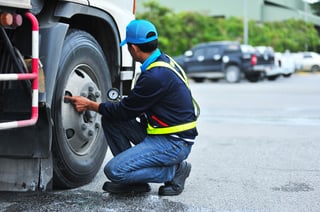National Tire Safety Week is scheduled for June 26 – July 3. This annual campaign, organized by the U.S. Tire Manufacturers Association, serves as a crucial initiative to raise awareness about the significance of proper tire care and maintenance. As a responsible fleet operator, ensuring tire safety should be a top priority.
This two-part blog series aims to provide valuable insights and practical advice on maintaining optimal tire conditions for fleet operations. In Part 1, we will look at the importance of tire pressure monitoring systems and the significance of daily and weekly tire pressure checks.

The Evolution of TPMS Systems:
Tire Pressure Monitoring Systems (TPMS) have significantly improved in recent years. With a wide range of solutions available, choosing the right TPMS for your fleet is crucial. In the Class 8 market, direct TPMS systems are recommended for their accuracy and reliability. Some fleet maintenance software and telematics systems even offer integration options, allowing seamless reporting and enhanced tire monitoring capabilities.
Daily Tire Pressure Checks:
Among the most controllable variables affecting tire safety is tire pressure. Daily monitoring during pre or post trip inspections is highly recommended. Equip your drivers with tire pressure gauges, assigning one to each truck. These gauges should be calibrated by the shop during scheduled maintenance to ensure accuracy. By incorporating daily checks into their routine, drivers can identify potential issues early on, reducing the risk of tire-related incidents on the road.
Weekly Tire Pressure Inspections:
In addition to daily checks, it is important to conduct comprehensive weekly tire pressure inspections. Consider designating an employee or engaging a reliable third-party service to perform these inspections on a day when most vehicles are idle. This proactive approach ensures that tire pressure remains optimal throughout the week, minimizing the likelihood of unexpected problems during operations. Remember, proper tire care is key to maximizing safety and optimizing your fleet’s performance. Stay tuned for Part 2 of this blog series, where we will review additional best practices, including the implementation of safety lanes and the benefits of properly inflated tires.








